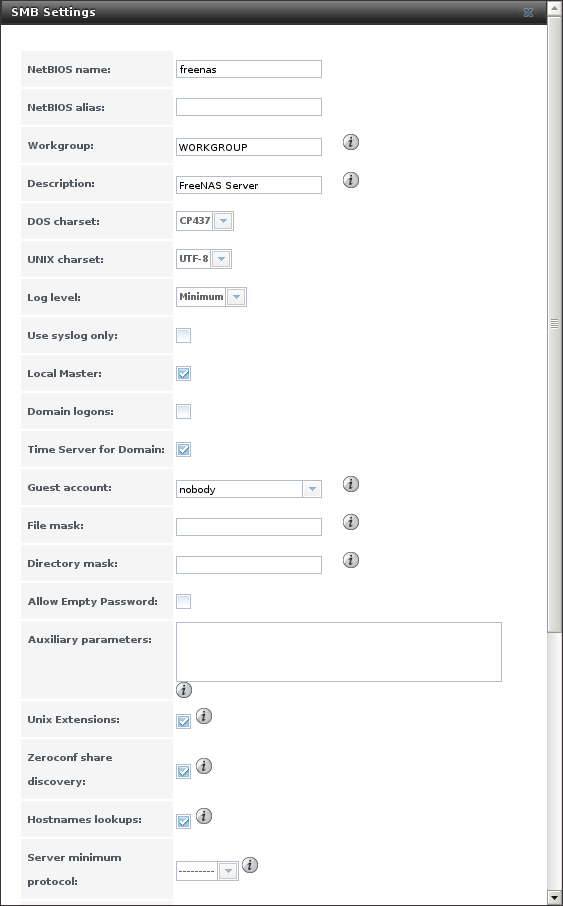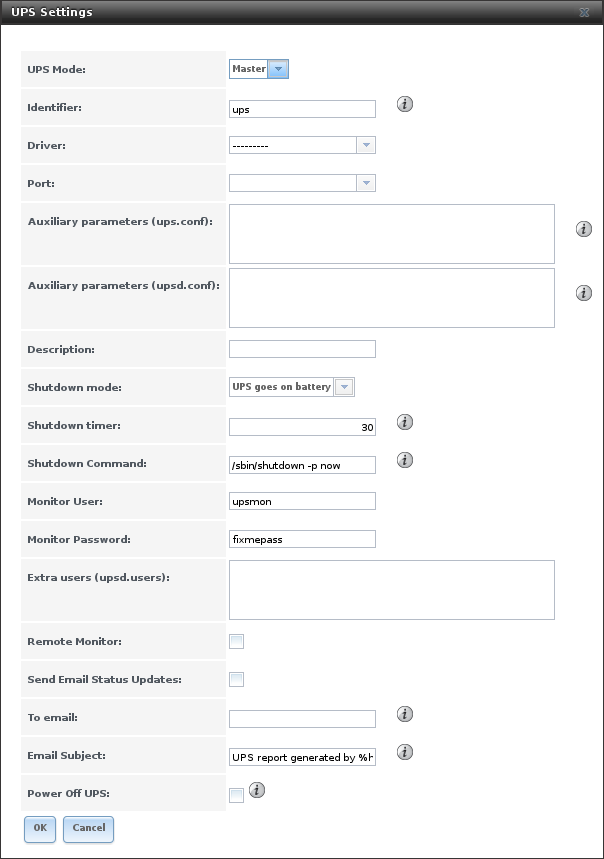11. Services¶
The Services section of the GUI is where various services that ship with the FreeNAS® system are configured, started, or stopped. FreeNAS® includes these built-in services:
This section demonstrates starting a FreeNAS® service and the available configuration options for each FreeNAS® service.
11.1. Control Services¶
Services → Control Services, shown in
Figure 11.1.1,
shows which services are currently running and can start, stop, or
configure them. The S.M.A.R.T. service is enabled by default, but only
runs if the storage devices support
S.M.A.R.T. data
Other services default to off until started.
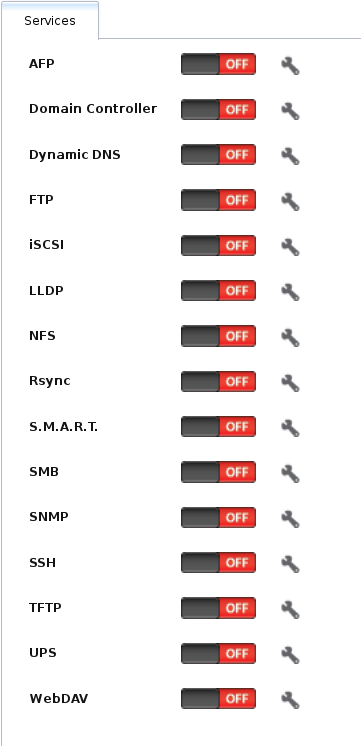
Fig. 11.1.1 Control Services
A service is stopped if its icon is a red OFF. A service is running if the icon is a blue ON. To start or stop a service, click the ON/OFF icon.
To configure a service, click the wrench icon associated with the service or click the name of the service in the Services section of the tree menu.
If a service does not start, go to
System → Advanced
and check the box Show console messages in the footer.
Console messages will now show at the bottom of the browser. Clicking
the console messages area will make it into a pop-up window, allowing
scrolling through the output and copying messages. Watch these
messages for errors when stopping or starting the problematic service.
To read the system logs for more information about a service failure, open Shell and type more /var/log/messages.
11.2. AFP¶
The settings that are configured when creating AFP Shares in
Sharing → Apple (AFP) Shares → Add Apple (AFP)
Share are specific to each configured AFP Share. In contrast, global
settings which apply to all AFP shares are configured in
Services → AFP.
Figure 11.2.1 shows the available global AFP configuration options which are described in Table 11.2.1.
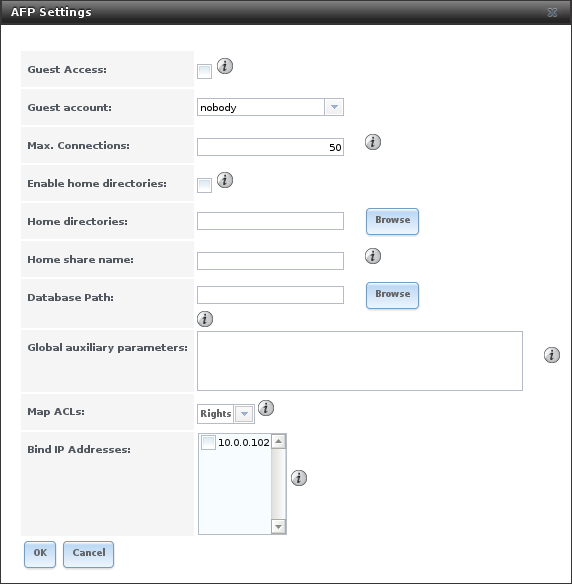
Fig. 11.2.1 Global AFP Configuration
| Setting | Value | Description |
|---|---|---|
| Guest Access | checkbox | if checked, clients will not be prompted to authenticate before accessing AFP shares |
| Guest account | drop-down menu | select account to use for guest access; the selected account must have permissions to the volume or dataset being shared |
| Max Connections | integer | maximum number of simultaneous connections |
| Enable home directories | checkbox | if checked, any user home directories located under Home directories will be available over the share |
| Home directories | browse button | select the volume or dataset which contains user home directories |
| Home share name | string | overrides default home folder name with the specified value |
| Database Path | browse button | select the path to store the CNID databases used by AFP (default is the root of the volume); the path must be writable |
| Global auxiliary parameters | string | additional afp.conf(5) parameters not covered elsewhere in this screen |
| Map ACLs | drop-down menu | choose mapping of effective permissions for authenticated users; Rights (default, Unix-style permissions), Mode (ACLs), or None |
| Bind IP Addresses | selection | specify the IP addresses to listen for FTP connections; highlight the desired IP addresses in the Available list and use the >> button to add to the Selected list |
When configuring home directories, it is recommended to create a
dataset to hold the home directories which contains a child dataset
for each user. As an example, create a dataset named
volume1/homedirs and browse to this dataset when configuring
the Home directories field of the AFP service. Then, as
you create each user, first create a child dataset for that user. For
example, create a dataset named volume1/homedirs/user1. When
you create the user1 user, browse to the
volume1/homedirs/user1 dataset in the
Home Directory field of the Add New User
screen.
11.2.1. Troubleshooting AFP¶
You can determine which users are connected to an AFP share by typing afpusers.
If Something wrong with the volume’s CNID DB is shown, run this command from Shell, replacing the path to the problematic AFP share:
dbd -rf /path/to/share
This command may take a while, depending upon the size of the volume or dataset being shared. This command will wipe the CNID database and rebuild it from the CNIDs stored in the AppleDouble files.
11.3. Domain Controller¶
FreeNAS® can be configured to act either as the domain controller for a network or to join an existing Active Directory network as a domain controller.
Note
This section demonstrates how to configure the FreeNAS® system to act as a domain controller. If the goal is to integrate with an existing Active Directory network to access its authentication and authorization services, configure Active Directory instead.
Be aware that configuring a domain controller is a complex process
that requires a good understanding of how Active Directory
works. While
Services → Domain Controller
makes it easy to input the needed settings into the administrative
graphical interface, it is important to understand what those settings
should be. Before beginning configuration, read through the
Samba AD DC HOWTO.
After FreeNAS® is configured, use the RSAT utility from a Windows
system to manage the domain controller. The Samba AD DC HOWTO includes
instructions for installing and configuring RSAT.
Figure 11.3.1 shows the configuration screen for creating a domain controller and Table 11.3.1 summarizes the available options.
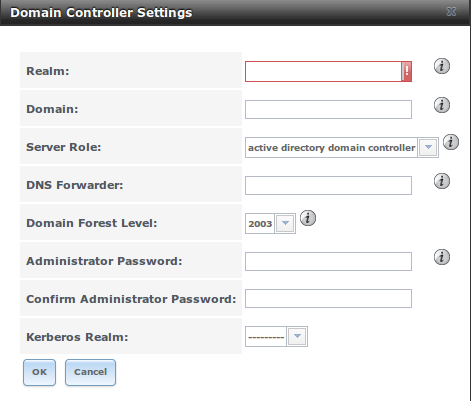
Fig. 11.3.1 Domain Controller Settings
| Setting | Value | Description |
|---|---|---|
| Realm | string | capitalized DNS realm name |
| Domain | string | capitalized domain name |
| Server Role | drop-down menu | at this time, the only supported role is as the domain controller for a new domain |
| DNS Forwarder | string | IP address of DNS forwarder; required for recursive queries when SAMBA_INTERNAL is selected |
| Domain Forest Level | drop-down menu | choices are 2000, 2003, 2008, or 2008_R2; refer to Understanding Active Directory Domain Services (AD DS) Functional Levels for details |
| Administrator password | string | password to be used for the Active Directory administrator account |
| Kerberos Realm | drop-down menu | auto-populates with information from the Realm when the settings in this screen are saved |
11.4. Dynamic DNS¶
Dynamic DNS (DDNS) is useful if the FreeNAS® system is connected to an ISP that periodically changes the IP address of the system. With dynamic DNS, the system can automatically associate its current IP address with a domain name, allowing you to access the FreeNAS® system even if the IP address changes. DDNS requires you to register with a DDNS service such as DynDNS.
Figure 11.4.1
shows the DDNS configuration screen and
Table 11.4.1
summarizes the configuration options. The values to enter will be
provided by the DDNS provider. After configuring DDNS, remember to
start the DDNS service in
Services → Control Services.
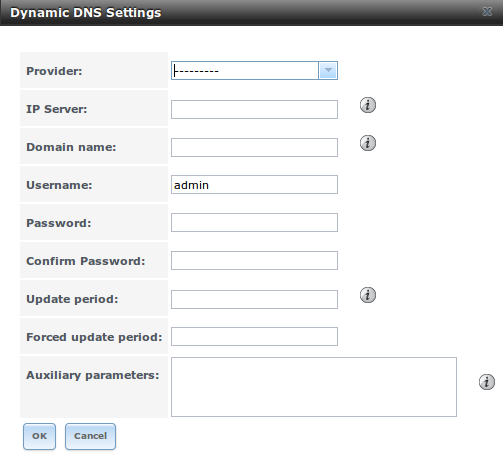
Fig. 11.4.1 Configuring DDNS
| Setting | Value | Description |
|---|---|---|
| Provider | drop-down menu | several providers are supported; if your provider is not listed, leave this field blank and specify the custom provider in the Auxiliary parameters field |
| IP Server | string | can be used to specify the hostname and port of the IP check server |
| Domain name | string | fully qualified domain name (e.g. yourname.dyndns.org) |
| Username | string | username used to logon to the provider and update the record |
| Password | string | password used to logon to the provider and update the record |
| Update period | integer | how often the IP is checked in seconds |
| Forced update period | integer | how often the IP should be updated, even it has not changed, in seconds |
| Auxiliary parameters | string | additional parameters passed to the provider during record update; an example of specifying a custom provider is dyndns_system default@provider.com |
When using “freedns.afraid.org”, see this forum post for an example configuration.
When using “he.net”, enter the domain name for Username and enter the DDNS key generated for that domain’s A entry at the he.net website for Password.
11.5. FTP¶
FreeNAS® uses the proftpd FTP server to provide FTP services. Once the FTP service is configured and started, clients can browse and download data using a web browser or FTP client software. The advantage of FTP is that easy-to-use cross-platform utilities are available to manage uploads to and downloads from the FreeNAS® system. The disadvantage of FTP is that it is considered to be an insecure protocol, meaning that it should not be used to transfer sensitive files. If you are concerned about sensitive data, see Encrypting FTP.
This section provides an overview of the FTP configuration options. It then provides examples for configuring anonymous FTP, specified user access within a chroot environment, encrypting FTP connections, and troubleshooting tips.
Figure 11.5.1
shows the configuration screen for
Services → FTP. Some settings are only available in
Advanced Mode. To see these settings, either click the
Advanced Mode button or configure the system to always
display these settings by checking the box
Show advanced fields by default in
System → Advanced.

Fig. 11.5.1 Configuring FTP
Table 11.5.1 summarizes the available options when configuring the FTP server.
| Setting | Value | Advanced Mode | Description |
|---|---|---|---|
| Port | integer | port the FTP service listens on | |
| Clients | integer | maximum number of simultaneous clients | |
| Connections | integer | maximum number of connections per IP address where 0 means unlimited | |
| Login Attempts | integer | maximum number of attempts before client is disconnected; increase this if users are prone to typos | |
| Timeout | integer | maximum client idle time in seconds before client is disconnected | |
| Allow Root Login | checkbox | discouraged as increases security risk | |
| Allow Anonymous Login | checkbox | enables anonymous FTP logins with access to the directory specified in Path | |
| Path | browse button | root directory for anonymous FTP connections | |
| Allow Local User Login | checkbox | required if Anonymous Login is disabled | |
| Display Login | string | message displayed to local login users after authentication; not displayed to anonymous login users | |
| File Permission | checkboxes | ✓ | sets default permissions for newly created files |
| Directory Permission | checkboxes | ✓ | sets default permissions for newly created directories |
| Enable FXP | checkbox | ✓ | enables File eXchange Protocol which is discouraged as it makes the server vulnerable to FTP bounce attacks |
| Allow Transfer Resumption | checkbox | allows FTP clients to resume interrupted transfers | |
| Always Chroot | checkbox | a local user is only allowed access to their home directory unless the user is a member of group wheel | |
| Require IDENT Authentication | checkbox | ✓ | will result in timeouts if identd is not running on the client |
| Perform Reverse DNS Lookups | checkbox | perform reverse DNS lookups on client IPs; can cause long delays if reverse DNS is not configured | |
| Masquerade address | string | public IP address or hostname; set if FTP clients cannot connect through a NAT device | |
| Minimum passive port | integer | ✓ | used by clients in PASV mode, default of 0 means any port above 1023 |
| Maximum passive port | integer | ✓ | used by clients in PASV mode, default of 0 means any port above 1023 |
| Local user upload bandwidth | integer | ✓ | in KB/s, default of 0 means unlimited |
| Local user download bandwidth | integer | ✓ | in KB/s, default of 0 means unlimited |
| Anonymous user upload bandwidth | integer | ✓ | in KB/s, default of 0 means unlimited |
| Anonymous user download bandwidth | integer | ✓ | in KB/s, default of 0 means unlimited |
| Enable TLS | checkbox | ✓ | enables encrypted connections and requires a certificate to be created or imported using Certificates |
| TLS policy | drop-down menu | ✓ | the selected policy defines whether the control channel, data channel, both channels, or neither channel of an FTP session must occur over SSL/TLS; the policies are described here |
| TLS allow client renegotiations | checkbox | ✓ | checking this box is not recommended as it breaks several security measures; for this and the rest of the TLS fields, refer to mod_tls for more details |
| TLS allow dot login | checkbox | ✓ | if checked, the user’s home directory is checked for a
.tlslogin file which contains one or more PEM-encoded
certificates; if not found, the user is prompted for password
authentication |
| TLS allow per user | checkbox | ✓ | if checked, the user’s password may be sent unencrypted |
| TLS common name required | checkbox | ✓ | if checked, the common name in the certificate must match the FQDN of the host |
| TLS enable diagnostics | checkbox | ✓ | if checked when troubleshooting a connection, logs more verbosely |
| TLS export certificate data | checkbox | ✓ | if checked, exports the certificate environment variables |
| TLS no certificate request | checkbox | ✓ | try checking this box if the client cannot connect and it is suspected that the client software is not properly handling the server’s certificate request |
| TLS no empty fragments | checkbox | ✓ | checking this box is not recommended as it bypasses a security mechanism |
| TLS no session reuse required | checkbox | ✓ | checking this box reduces the security of the connection, so only use it if the client does not understand reused SSL sessions |
| TLS export standard vars | checkbox | ✓ | if checked, sets several environment variables |
| TLS DNS name required | checkbox | ✓ | if checked, the client’s DNS name must resolve to its IP address and the cert must contain the same DNS name |
| TLS IP address required | checkbox | ✓ | if checked, the client’s certificate must contain the IP address that matches the IP address of the client |
| Certificate | drop-down menu | the SSL certificate to be used for TLS FTP connections; to create a
certificate, use System → Certificates |
|
| Auxiliary parameters | string | ✓ | used to add proftpd(8) parameters not covered elsewhere in this screen |
This example demonstrates the auxiliary parameters that prevent all users from performing the FTP DELETE command:
<Limit DELE>
DenyAll
</Limit>
11.5.1. Anonymous FTP¶
Anonymous FTP may be appropriate for a small network where the FreeNAS® system is not accessible from the Internet and everyone in your internal network needs easy access to the stored data. Anonymous FTP does not require you to create a user account for every user. In addition, passwords are not required so it is not necessary to manage changed passwords on the FreeNAS® system.
To configure anonymous FTP:
Give the built-in ftp user account permissions to the volume/dataset to be shared in
Storage → Volumesas follows:- Owner(user): select the built-in ftp user from the drop-down menu
- Owner(group): select the built-in ftp group from the drop-down menu
- Mode: review that the permissions are appropriate for the share
Note
For FTP, the type of client does not matter when it comes to the type of ACL. This means that you always use Unix ACLs, even if Windows clients will be accessing FreeNAS® via FTP.
Configure anonymous FTP in
Services → FTPby setting the following attributes:- check the box Allow Anonymous Login
- Path: browse to the volume/dataset/directory to be shared
Start the FTP service in
Services → Control Services. Click the red OFF button next to FTP. After a second or so, it will change to a blue ON, indicating that the service has been enabled.Test the connection from a client using a utility such as Filezilla.
In the example shown in Figure 11.5.2, the user has enter the following information into the Filezilla client:
- IP address of the FreeNAS® server: 192.168.1.113
- Username: anonymous
- Password: the email address of the user

Fig. 11.5.2 Connecting Using Filezilla
The messages within the client indicate that the FTP connection is successful. The user can now navigate the contents of the root folder on the remote site—this is the volume/dataset that was specified in the FTP service configuration. The user can also transfer files between the local site (their system) and the remote site (the FreeNAS® system).
11.5.2. FTP in chroot¶
If you require your users to authenticate before accessing the data on the FreeNAS® system, you will need to either create a user account for each user or import existing user accounts using Active Directory or LDAP. If you then create a ZFS dataset for :each user, you can chroot each user so that they are limited to the contents of their own home directory. Datasets provide the added benefit of configuring a quota so that the size of the user’s home directory is limited to the size of the quota.
To configure this scenario:
Create a ZFS dataset for each user in
Storage → Volumes. Click an existingZFS volume → Create ZFS Datasetand set an appropriate quota for each dataset. Repeat this process to create a dataset for every user that needs access to the FTP service.If you are not using AD or LDAP, create a user account for each user in
Account → Users → Add User. For each user, browse to the dataset created for that user in the Home Directory field. Repeat this process to create a user account for every user that needs access to the FTP service, making sure to assign each user their own dataset.Set the permissions for each dataset in
Storage → Volumes. Click the Change Permissions button for a dataset to assign a user account as Owner of that dataset and to set the desired permissions for that user. Repeat for each dataset.Note
For FTP, the type of client does not matter when it comes to the type of ACL. This means that you always use Unix ACLs, even if Windows clients will be accessing FreeNAS® via FTP.
Configure FTP in
Services → FTPwith these attributes:- Path: browse to the parent volume containing the datasets
- make sure the boxes for Allow Anonymous Login and Allow Root Login are unchecked
- check the box Allow Local User Login
- check the box Always Chroot
Start the FTP service in
Services → Control Services. Click the red OFF button next to FTP. After a second or so, it will change to a blue ON, indicating that the service has been enabled.Test the connection from a client using a utility such as Filezilla.
To test this configuration in Filezilla, use the IP address of the FreeNAS® system, the Username of a user that has been associated with a dataset, and the Password for that user. The messages should indicate that the authorization and the FTP connection are successful. The user can now navigate the contents of the root folder on the remote site—this time it is not the entire volume but the dataset that was created for that user. The user should be able to transfer files between the local site (their system) and the remote site (their dataset on the FreeNAS® system).
11.5.3. Encrypting FTP¶
To configure any FTP scenario to use encrypted connections:
- Import or create a certificate authority using the instructions in CAs. Then, import or create the certificate to use for encrypted connections using the instructions in Certificates.
- In
Services → FTP, check the box Enable TLS and select the certificate in the Certificate drop-down menu. - Specify secure FTP when accessing the FreeNAS® system. For example, in Filezilla input ftps://IP_address (for an implicit connection) or ftpes://IP_address (for an explicit connection) as the Host when connecting. The first time a user connects, they will be presented with the certificate of the FreeNAS® system. Click OK to accept the certificate and negotiate an encrypted connection.
- To force encrypted connections, select on for the TLS Policy.
11.5.4. Troubleshooting FTP¶
The FTP service will not start if it cannot resolve the system’s hostname to an IP address using DNS. To see if the FTP service is running, open Shell and issue the command:
sockstat -4p 21
If there is nothing listening on port 21, the FTP service is not
running. To see the error message that occurs when FreeNAS® tries to
start the FTP service, go to
System → Advanced,
check the box Show console messages in the footer and
click Save. Next, go to
Services → Control Services
and switch the FTP service off, then back on. Watch the console
messages at the bottom of the browser for errors.
If the error refers to DNS, either create an entry in the local DNS
server with the FreeNAS® system’s hostname and IP address or add an
entry for the IP address of the FreeNAS® system in the
Host name database field of
Network → Global Configuration.
11.6. iSCSI¶
Refer to Block (iSCSI) for instructions on configuring iSCSI. To start the iSCSI service, click its entry in Services.
Note
A warning message is shown if you stop the iSCSI service when initiators are connected. Type ctladm islist to determine the names of the connected initiators.
11.7. LLDP¶
The Link Layer Discovery Protocol (LLDP) is used by network devices to advertise their identity, capabilities, and neighbors on an Ethernet network. FreeNAS® uses the ladvd LLDP implementation. If your network contains managed switches, configuring and starting the LLDP service will tell the FreeNAS® system to advertise itself on the network.
Figure 11.7.1 shows the LLDP configuration screen and Table 11.7.1 summarizes the configuration options for the LLDP service.
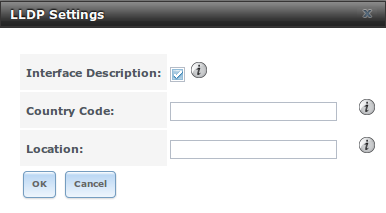
Fig. 11.7.1 Configuring LLDP
| Setting | Value | Description |
|---|---|---|
| Interface Description | checkbox | when checked, receive mode is enabled and received peer information is saved in interface descriptions |
| Country Code | string | required for LLDP location support; input 2 letter ISO 3166 country code |
| Location | string | optional; specify the physical location of the host |
11.8. NFS¶
The settings that are configured when creating NFS Shares in
Sharing → Unix (NFS) Shares
→ Add Unix (NFS) Share
are specific to each configured NFS Share. In contrast, global
settings which apply to all NFS shares are configured in
Services → NFS.
Figure 11.8.1 shows the configuration screen and Table 11.8.1 summarizes the configuration options for the NFS service.
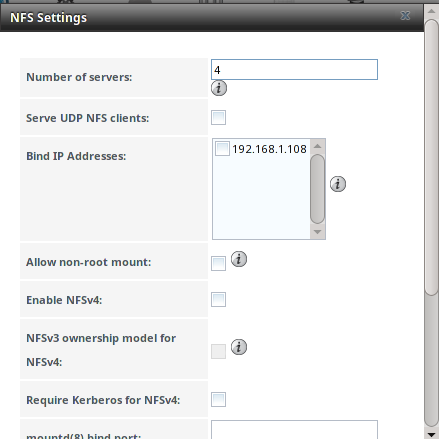
Fig. 11.8.1 Configuring NFS
| Setting | Value | Description |
|---|---|---|
| Number of servers | integer | the number of servers can be increased if NFS client responses are slow; to limit CPU context switching, keep
this number less than or equal to the number of CPUs reported by sysctl -n kern.smp.cpus. |
| Serve UDP NFS clients | checkbox | check if NFS clients need to use UDP |
| Bind IP Addresses | checkboxes | IP addresses to listen on for NFS requests; when unchecked, NFS listens on all available addresses |
| Allow non-root mount | checkbox | check this box only if the NFS client requires it |
| Enable NFSv4 | checkbox | NFSv3 is the default, check this box to switch to NFSv4 |
| NFSv3 ownership model for NFSv4 | checkbox | grayed out unless Enable NFSv4 is checked and, in turn, will gray out Support>16 groups which is incompatible; check this box if NFSv4 ACL support is needed without requiring the client and the server to sync users and groups |
| Require Kerberos for NFSv4 | checkbox | when checked, NFS shares will fail if the Kerberos ticket is unavailable |
| mountd(8) bind port | integer | optional; specify port that mountd(8) binds to |
| rpc.statd(8) bind port | integer | optional; specify port that rpc.statd(8) binds to |
| rpc.lockd(8) bind port | integer | optional; specify port that rpc.lockd(8) binds to |
| Support>16 groups | checkbox | check this box if any users are members of more than 16 groups (useful in AD environments); note that this assumes that group membership has been configured correctly on the NFS server |
Note
NFSv4 sets all ownership to nobody:nobody if user and group do not match on client and server.
11.9. Rsync¶
Services → Rsync
is used to configure an rsync server when using rsync module mode. See
the section on Rsync Module Mode for a configuration example.
This section describes the configurable options for the rsyncd service and rsync modules.
11.9.1. Configure Rsyncd¶
Figure 11.9.1
shows the rsyncd configuration screen which is accessed from
Services → Rsync → Configure Rsyncd.
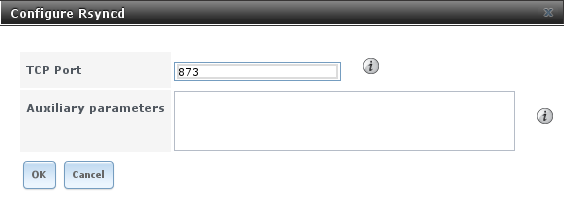
Fig. 11.9.1 Rsyncd Configuration
Table 11.9.1 summarizes the options that can be configured for the rsync daemon:
| Setting | Value | Description |
|---|---|---|
| TCP Port | integer | port for rsyncd to listen on, default is 873 |
| Auxiliary parameters | string | additional parameters from rsyncd.conf(5) |
11.9.2. Rsync Modules¶
Figure 11.9.2
shows the configuration screen that appears after clicking
Services → Rsync → Rsync Modules
→ Add Rsync Module.
Table 11.9.2 summarizes the options that can be configured when creating a rsync module.
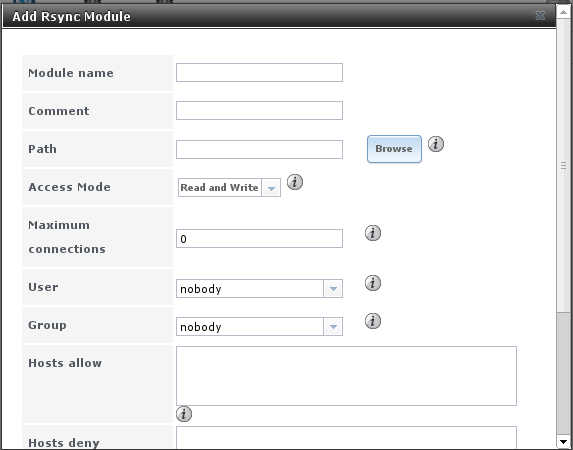
Fig. 11.9.2 Adding an Rsync Module
| Setting | Value | Description |
|---|---|---|
| Module name | string | mandatory; needs to match the setting on the rsync client |
| Comment | string | optional description |
| Path | browse button | volume/dataset to hold received data |
| Access Mode | drop-down menu | choices are Read and Write, Read-only, or Write-only |
| Maximum connections | integer | 0 is unlimited |
| User | drop-down menu | select user that file transfers to and from that module should take place as |
| Group | drop-down menu | select group that file transfers to and from that module should take place as |
| Hosts allow | string | see rsyncd.conf(5) for allowed formats |
| Hosts deny | string | see rsyncd.conf(5) for allowed formats |
| Auxiliary parameters | string | additional parameters from rsyncd.conf(5) |
11.10. S.M.A.R.T.¶
S.M.A.R.T., or Self-Monitoring, Analysis, and Reporting Technology, is an industry standard for disk monitoring and testing. Drives can be monitored for status and problems, and several types of self-tests can be run to check the drive health.
Tests run internally on the drive. Most tests can run at the same time as normal disk usage. However, a running test can greatly reduce drive performance, so they should be scheduled at times when the system is not busy or in normal use. It is very important to avoid scheduling disk-intensive tests at the same time. For example, do not schedule S.M.A.R.T. tests to run at the same time, or preferably, even on the same days as Scrubs.
Of particular interest in a NAS environment are the Short and Long S.M.A.R.T. tests. Details vary between drive manufacturers, but a Short test generally does some basic tests of a drive that takes a few minutes. The Long test scans the entire disk surface, and can take several hours on larger drives.
FreeNAS® uses the smartd(8) service to monitor S.M.A.R.T. information. A complete configuration consists of:
- Scheduling when S.M.A.R.T. tests are run in
Tasks → S.M.A.R.T. Tests → Add S.M.A.R.T. Test. - Enabling or disabling S.M.A.R.T. for each disk member of a volume
in
Volumes → View Volumes. This setting is enabled by default for disks that support S.M.A.R.T. - Checking the configuration of the S.M.A.R.T. service as described in this section.
- Starting the S.M.A.R.T. service with
Services → Control Services.
Figure 11.10.1
shows the configuration screen that appears after clicking
Services → S.M.A.R.T.
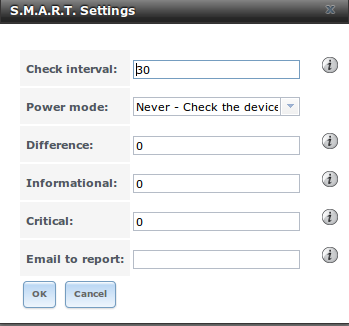
Fig. 11.10.1 S.M.A.R.T Configuration Options
Note
smartd wakes up at the configured
Check Interval. It checks the times configured in
Tasks → S.M.A.R.T. Tests
to see whether tests should be run. Since the smallest time
increment for a test is an hour (60 minutes), it does not make
sense to set a Check Interval value higher than 60
minutes. For example, if the Check Interval is set to
120 minutes and the smart test to every hour, the test will only
be run every two hours because smartd only wakes up
every two hours.
Table 11.10.1 summarizes the options in the S.M.A.R.T configuration screen.
| Setting | Value | Description |
|---|---|---|
| Check interval | integer | in minutes, how often smartd wakes up to check if any tests have been configured to run |
| Power mode | drop-down menu | tests are not performed if the system enters the specified power mode; choices are: Never, Sleep, Standby, or Idle |
| Difference | integer in degrees Celsius | default of 0 disables this check, otherwise reports if the temperature of a drive has changed by N degrees Celsius since last report |
| Informational | integer in degrees Celsius | default of 0 disables this check, otherwise will message with a log level of LOG_INFO if the temperature is higher than specified degrees in Celsius |
| Critical | integer in degrees Celsius | default of 0 disables this check, otherwise will message with a log level of LOG_CRIT and send an email if the temperature is higher than specified degrees in Celsius |
| Email to report | string | email address of person or alias to receive S.M.A.R.T. alerts |
11.11. SMB¶
The settings that are configured when creating SMB Shares in
Sharing → Windows (SMB) Shares
→ Add Windows (SMB) Share
are specific to each configured SMB Share. In contrast, global
settings which apply to all SMB shares are configured in
Services → SMB.
Note
After starting the SMB service, it may take several minutes for the master browser election to occur and for the FreeNAS® system to become available in Windows Explorer.
Figure 11.11.1 shows the global SMB configuration options which are described in Table 11.11.1. This configuration screen is really a front-end to smb4.conf.
| Setting | Value | Description |
|---|---|---|
| NetBIOS Name | string | automatically populated with the system’s original hostname; limited to 15 characters; it must be different from the Workgroup name |
| Workgroup | string | must match Windows workgroup name; this setting is ignored if the Active Directory or LDAP service is running |
| Description | string | optional |
| DOS charset | drop-down menu | the character set Samba uses when communicating with DOS and Windows 9x/ME clients; default is CP437 |
| UNIX charset | drop-down menu | default is UTF-8 which supports all characters in all languages |
| Log level | drop-down menu | choices are Minimum, Normal, or Debug |
| Use syslog only | checkbox | when checked, authentication failures are logged to /var/log/messages instead of the default
of /var/log/samba4/log.smbd |
| Local Master | checkbox | determines whether or not the system participates in a browser election; should be disabled when network contains an AD or LDAP server and is not necessary if Vista or Windows 7 machines are present |
| Domain logons | checkbox | only check if need to provide the netlogin service for older Windows clients |
| Time Server for Domain | checkbox | determines whether or not the system advertises itself as a time server to Windows clients; should be disabled when network contains an AD or LDAP server |
| Guest Account | drop-down menu | account to be used for guest access; default is nobody; account must have permission to access the shared volume/dataset; if Guest Account user is deleted, resets to nobody |
| File mask | integer | overrides default file creation mask of 0666 which creates files with read and write access for everybody |
| Directory mask | integer | overrides default directory creation mask of 0777 which grants directory read, write and execute access for everybody |
| Allow Empty Password | checkbox | if checked, users can just press Enter when prompted for a password; requires that the
username/password be the same as the Windows user account |
| Auxiliary parameters | string | smb.conf options not covered elsewhere in this screen; see
the Samba Guide
for additional settings |
| Unix Extensions | checkbox | allows non-Windows SMB clients to access symbolic links and hard links, has no effect on Windows clients |
| Zeroconf share discovery | checkbox | enable if Mac clients will be connecting to the SMB share |
| Hostnames lookups | checkbox | allows using hostnames rather than IP addresses in the Hosts Allow or Hosts Deny fields of a SMB share; uncheck if IP addresses are used to avoid the delay of a host lookup |
| Server minimum protocol | drop-down menu | the minimum protocol version the server will support where the default sets automatic negotiation; refer to Table 11.11.2 for descriptions |
| Server maximum protocol | drop-down menu | the maximum protocol version the server will support; refer to Table 11.11.2 for descriptions |
| Allow execute always | checkbox | if checked, Samba will allow the user to execute a file, even if that user’s permissions are not set to execute |
| Obey pam restrictions | checkbox | uncheck this box to allow cross-domain authentication, to allow users and groups to be managed on another forest, or to allow permissions to be delegated from Active Directory users and groups to domain admins on another forest |
| Bind IP Addresses | checkboxes | check the IP addresses on which SMB should listen |
| Idmap Range Low | integer | the beginning UID/GID for which this system is authoritative; any UID/GID lower than this value is ignored, providing a way to avoid accidental UID/GID overlaps between local and remotely defined IDs |
| Idmap Range High | integer | the ending UID/GID for which this system is authoritative; any UID/GID higher than this value is ignored, providing a way to avoid accidental UID/GID overlaps between local and remotely defined IDs |
| Value | Description |
|---|---|
| CORE | used by DOS |
| COREPLUS | used by DOS |
| LANMAN1 | used by Windows for Workgroups, OS/2, and Windows 9x |
| LANMAN2 | used by Windows for Workgroups, OS/2, and Windows 9x |
| NT1 | used by Windows NT |
| SMB2 | used by Windows 7; same as SMB2_10 |
| SMB2_02 | used by Windows Vista |
| SMB2_10 | used by Windows 7 |
| SMB3 | used by Windows 8 |
| SMB3_00 | used by Windows 8 |
| SMB3_02 | used by Windows 8.1 and Windows Server 2012 |
| SMB3_11 | used by Windows 10 |
Changes to SMB settings and SMB shares take effect immediately.
Note
Do not set the directory name cache size as an Auxiliary parameter. Due to differences in how Linux and BSD handle file descriptors, directory name caching is disabled on BSD systems to improve performance.
Note
SMB cannot be disabled while Active Directory is enabled.
11.11.1. Troubleshooting SMB¶
Samba is single threaded, so CPU speed makes a big difference in SMB performance. A typical 2.5Ghz Intel quad core or greater should be capable of handling speeds in excess of Gb LAN while low power CPUs such as Intel Atoms and AMD C-30sE-350E-450 will not be able to achieve more than about 30-40MB/sec typically. Remember that other loads such as ZFS will also require CPU resources and may cause Samba performance to be less than optimal.
Samba’s write cache parameter has been reported to improve write performance in some configurations and can be added to the Auxiliary parameters field. Use an integer value which is a multiple of _SC_PAGESIZE (typically 4096) to avoid memory fragmentation. This will increase Samba’s memory requirements and should not be used on systems with limited RAM.
To increase network performance, read the Samba section on socket options in the smb.conf manual page. It indicates which options are available and recommends that you experiment to see which are supported by your clients and improve your network’s performance.
Windows automatically caches file sharing information. If you make changes to a SMB share or to the permissions of a volume/dataset being shared by SMB and are no longer able to access the share, try logging out and back into the Windows system. Alternately, users can type net use /delete from the command line to clear their SMB sessions.
Windows also automatically caches login information. If you want users to be prompted to log in every time access is required, reduce the cache settings on the client computers.
Where possible, avoid using a mix of case in filenames as this can cause confusion for Windows users. Representing and resolving filenames with Samba explains in more detail.
If a particular user cannot connect to a SMB share, make sure that their password does not contain the ? character. If it does, have the user change the password and try again.
If permissions work for Windows users but not for OS X users, try disabling Unix Extensions and restarting the SMB service.
If the SMB service will not start, run this command from Shell to see if there is an error in the configuration:
testparm /usr/local/etc/smb4.conf
If clients have problems connecting to the SMB share, go to
Services → SMB and verify that
Server maximum protocol is set to SMB2.
It is recommended to use a dataset for SMB sharing. When creating the dataset, make sure that the Share type is set to Windows.
Do not use chmod to attempt to fix the permissions on a SMB share as it destroys the Windows ACLs. The correct way to manage permissions on a SMB share is to manage the share security from a Windows system as either the owner of the share or a member of the group that owns the share. To do so, right-click on the share, click Properties and navigate to the Security tab. If you already destroyed the ACLs using chmod, winacl can be used to fix them. Type winacl from Shell for usage instructions.
The Common Errors section of the Samba documentation contains additional troubleshooting tips.
11.12. SNMP¶
SNMP (Simple Network Management Protocol) is used to monitor network-attached devices for conditions that warrant administrative attention. FreeNAS® uses Net-SNMP to provide SNMP. When you start the SNMP service, the following port will be enabled on the FreeNAS® system:
- UDP 161 (listens here for SNMP requests)
Available MIBS are located in /usr/local/share/snmp/mibs.
Figure 11.12.1 shows the SNMP configuration screen. Table 11.12.1 summarizes the configuration options.
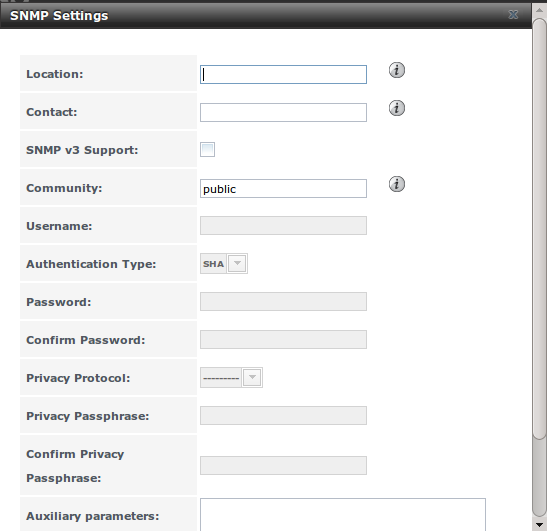
Fig. 11.12.1 Configuring SNMP
| Setting | Value | Description |
|---|---|---|
| Location | string | optional description of system’s location |
| Contact | string | optional email address of administrator |
| SNMP v3 Support | checkbox | check this box to enable support for SNMP version 3 |
| Community | string | default is public and should be changed for security reasons; can only contain alphanumeric characters, underscores, dashes, periods, and spaces; this value can be empty for SNMPv3 networks |
| Username | string | only applies if SNMP v3 Support is checked; specify the username to register with this service; refer to snmpd.conf(5) for more information regarding the configuration of this setting as well as the Authentication Type, Password, Privacy Protocol, and “Privacy Passphrase” fields |
| Authentication Type | drop-down menu | only applies if SNMP v3 Support is checked; choices are MD5 or SHA |
| Password | string | only applies if SNMP v3 Support is checked; specify and confirm a password of at least eight characters |
| Privacy Protocol | drop-down menu | only applies if SNMP v3 Support is checked; choices are AES or DES |
| Privacy Passphrase | string | if not specified, Password is used |
| Auxiliary Parameters | string | additional snmpd.conf(5) options not covered in this screen, one per line |
11.13. SSH¶
Secure Shell (SSH) allows for files to be transferred securely over an encrypted network. If you configure your FreeNAS® system as an SSH server, the users in your network will need to use SSH client software to transfer files with SSH.
This section shows the FreeNAS® SSH configuration options, demonstrates an example configuration that restricts users to their home directory, and provides some troubleshooting tips.
Figure 11.13.1
shows the
Services → SSH
configuration screen. After configuring SSH, remember to start it in
Services → Control Services.
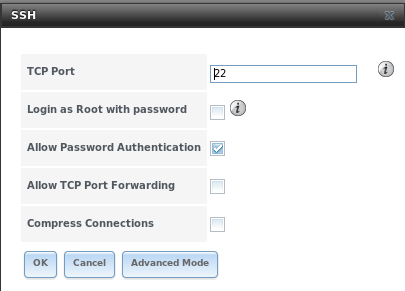
Fig. 11.13.1 SSH Configuration
Table 11.13.1
summarizes the configuration options. Some settings are only available
in Advanced Mode. To see these settings, either click the
Advanced Mode button, or configure the system to always
display these settings by checking the box
Show advanced fields by default in
System → Advanced.
| Setting | Value | Advanced Mode | Description |
|---|---|---|---|
| Bind Interfaces | selection | ✓ | by default, SSH listens on all interfaces unless specific interfaces are highlighted in the Available field and added to the Selected field |
| TCP Port | integer | port to open for SSH connection requests; 22 by default | |
| Login as Root with password | checkbox | for security reasons, root logins are discouraged and disabled by default if enabled, password must be set for root user in View Users | |
| Allow Password Authentication | checkbox | if unchecked, key-based authentication for all users is required; requires additional setup on both the SSH client and server | |
| Allow Kerberos Authentication | checkbox | before checking this box, ensure that Kerberos Realms and Kerberos Keytabs have been configured and that the FreeNAS® system can communicate with the KDC | |
| Allow TCP Port Forwarding | checkbox | allows users to bypass firewall restrictions using SSH’s port forwarding feature | |
| Compress Connections | checkbox | may reduce latency over slow networks | |
| SFTP Log Level | drop-down menu | ✓ | select the syslog(3) level of the SFTP server |
| SFTP Log Facility | drop-down menu | ✓ | select the syslog(3) facility of the SFTP server |
| Extra Options | string | ✓ | additional sshd_config(5) options not covered in this screen, one per line; these options are case-sensitive and misspellings may prevent the SSH service from starting |
A few sshd_config(5) options that are useful to enter in the Extra Options field include:
- increase the ClientAliveInterval if SSH connections tend to drop
- ClientMaxStartup defaults to 10; increase this value if you need more concurrent SSH connections
11.13.1. SCP Only¶
When you configure SSH, authenticated users with a user account
created using
Account → Users → Add User
can use the ssh command to login to the FreeNAS® system over
the network. A user’s home directory will be the volume/dataset
specified in the Home Directory field of their FreeNAS®
user account. While the SSH login will default to the user’s home
directory, users are able to navigate outside of their home directory,
which can pose a security risk.
It is possible to allow users to use the scp and
sftp commands to transfer files between their local
computer and their home directory on the FreeNAS® system, while
restricting them from logging into the system using ssh. To
configure this scenario, go to
Account → Users → View Users,
select the user and click Modify User, and change the
user’s Shell to scponly. Repeat for each user that needs
restricted SSH access.
Test the configuration from another system by running the sftp, ssh, and scp commands as the user. The sftp and scp commands should work but the ssh should fail.
Note
Some utilities such as WinSCP and Filezilla can bypass the scponly shell. This section assumes that users are accessing the system using the command line versions of scp and sftp.
11.13.2. Troubleshooting SSH¶
When adding any Extra Options, be aware that the keywords listed in sshd_config(5) are case sensitive. This means that your configuration will fail to do what you intended if you do not match the upper and lowercase letters of the keyword.
If your clients are receiving “reverse DNS” or timeout errors, add an
entry for the IP address of the FreeNAS® system in the
Host name database field of
Network → Global Configuration.
When configuring SSH, always test your configuration as an SSH user account to ensure that the user is limited to what you have configured and that they have permission to transfer files within the intended directories. If the user account is experiencing problems, the SSH error messages are usually pretty specific to what the problem is. Type the following command within Shell to read these messages as they occur:
tail -f /var/log/messages
Additional messages regarding authentication errors may be found in
/var/log/auth.log.
11.14. TFTP¶
Trivial File Transfer Protocol (TFTP) is a light-weight version of FTP usually used to transfer configuration or boot files between machines, such as routers, in a local environment. TFTP provides an extremely limited set of commands and provides no authentication.
If the FreeNAS® system will be used to store images and configuration files for the network’s devices, configure and start the TFTP service. Starting the TFTP service will open UDP port 69.
Figure 11.14.1 shows the TFTP configuration screen and Table 11.14.1 summarizes the available options:
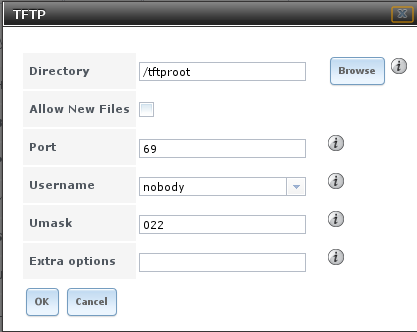
Fig. 11.14.1 TFTP Configuration
| Setting | Value | Description |
|---|---|---|
| Directory | browse button | browse to an existing directory to be used for storage; some devices require a specific directory name, refer to the device’s documentation for details |
| Allow New Files | checkbox | enable if network devices need to send files to the system (e.g. backup their config) |
| Port | integer | UDP port to listen for TFTP requests, 69 by default |
| Username | drop-down menu | account used for tftp requests; must have permission to the Directory |
| Umask | integer | umask for newly created files, default is 022 (everyone can read, nobody can write); some devices require a less strict umask |
| Extra options | string | additional tftpd(8) options not shown in this screen, one per line |
11.15. UPS¶
FreeNAS® uses
NUT
(Network UPS Tools) to provide UPS support. If the FreeNAS® system is
connected to a UPS device, configure the UPS service then start it in
Services → Control Services.
Figure 11.15.1 shows the UPS configuration screen:
Table 11.15.1 summarizes the options in the UPS Configuration screen.
| Setting | Value | Description |
|---|---|---|
| UPS Mode | drop-down menu | select from Master or Slave |
| Identifier | string | can contain alphanumeric, period, comma, hyphen, and underscore characters |
| Driver | drop-down menu | supported UPS devices are listed at http://www.networkupstools.org/stable-hcl.html |
| Port | drop-down menu | select the serial or USB port the UPS is plugged into (see NOTE below) |
| Auxiliary Parameters (ups.conf) | string | additional options from ups.conf(5) |
| Auxiliary Parameters (upsd.conf) | string | additional options from upsd.conf(5) |
| Description | string | optional |
| Shutdown mode | drop-down menu | choices are UPS goes on battery and UPS reaches low battery |
| Shutdown timer | integer | in seconds; will initiate shutdown after this many seconds after UPS enters UPS goes on battery, unless power is restored |
| Shutdown Command | string | the command to run to shut down the computer when battery power is low or shutdown timer runs out |
| Monitor User | string | default is upsmon |
| Monitor Password | string | default is known value fixmepass and should be changed; cannot contain a space or # |
| Extra users | string | defines the accounts that have administrative access; see upsd.users(5) for examples |
| Remote monitor | checkbox | if enabled, be aware that the default is to listen on all interfaces and to use the known values user upsmon and password fixmepass |
| Send Email Status Updates | checkbox | if checked, activates the To email field |
| To email | email address | if Send Email box checked, email address to receive status updates; separate multiple email addresses with a semicolon |
| Email Subject | string | subject line to be used in the email |
| Power Off UPS | checkbox | if checked, the UPS will also power off after shutting down the FreeNAS system |
Note
For USB devices, the easiest way to determine the correct
device name is to check the box Show console messages
in
System → Advanced.
Plug in the USB device and console messages show the name of the
/dev/ugenX.X device, where the X’s are the numbers that show on
the console.
upsc(8) can be used to get status variables from the UPS daemon such as the current charge and input voltage. It can be run from Shell using the following syntax. The man page gives some other usage examples.
upsc ups@localhost
upscmd(8) can be used to send commands directly to the UPS, assuming that the hardware supports the command being sent. Only users with administrative rights can use this command. These users are created in the Extra users field.
11.15.1. Multiple Computers with One UPS¶
A UPS with adequate capacity can be used to power multiple computers. One computer is connected to the UPS data port with a serial or USB cable. This master makes UPS status available on the network for other computers. These slave computers are powered by the UPS, but receive UPS status data from the master computer. See the NUT User Manual and NUT User Manual Pages.
11.16. WebDAV¶
The WebDAV service can be configured to provide a file browser over a
web connection. Before starting this service, you must create at least
one WebDAV share using
Sharing → WebDAV Shares → Add WebDAV Share.
Refer to WebDAV Shares for instructions on how to create a
share and then how to connect to it once the service is configured and
started.
The settings in the WebDAV service apply to all WebDAV shares. Figure 11.16.1 shows the WebDAV configuration screen. Table 11.16.1 summarizes the available options.
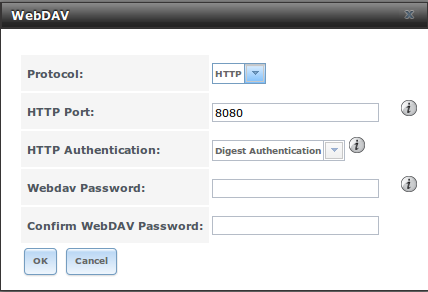
Fig. 11.16.1 WebDAV Configuration Screen
| Setting | Value | Description |
|---|---|---|
| Protocol | drop-down menu | choices are HTTP (connection always unencrypted), HTTPS (connection always encrypted), or HTTP+HTTPS (both types of connections allowed) |
| HTTP Port | string | only appears if the selected Protocol is HTTP or HTTP+HTTPS and is used to specify the port to be used for unencrypted connections; the default of 8080 should work, if you change it, do not use a port number already being used by another service |
| HTTPS Port | string | only appears if the selected Protocol is HTTPS or HTTP+HTTPS and is used to specify the port to be used for encrypted connections; the default of 8081 should work, if you change it, do not use a port number already being used by another service |
| Webdav SSL Certificate | drop-down menu | only appears if the selected Protocol is HTTPS or
HTTP+HTTPS; select the SSL certificate to be used for encrypted connections; to create a
certificate, use System → Certificates |
| HTTP Authentication | drop-down menu | choices are Basic Authentication (unencrypted) or Digest Authentication (encrypted) |
| Webdav Password | string | default is davtest; this should be changed as it is a known value |
